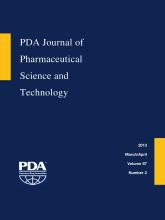Abstract
Carefully designed cleaning validation and its evaluation can ensure that residues of active pharmaceutical ingredient will not carry over and cross-contaminate the subsequent product. UV spectrophotometric and total organic carbon–solid sample module (TOC-SSM) method was developed and validated for the verification and determination of atorvastatin residues in the production area and to confirm the efficiency of the cleaning procedure as per ICH guideline. Atorvastatin was selected on the basis of a worst-case rating approach. It exhibited good linearity in the range of 5 to 25 μg/mL for UV spectrophotometric and 7300 to 83800 μg for the TOC-SSM method. The limit of detection was 0.419 μg/mL and 4.19 μg in the UV spectrophotometric and TOC-SSM methods, respectively. The limit of quantitation was 1.267 μg/mL and 12.69 μg in UV spectrophotometric and TOC-SSM methods, respectively. Percentage recovery from spiked stainless steel plates was found to be 95.37% and 92.82% in UV spectrophotometric and TOC-SSM methods, respectively. The calculated limit of acceptance per swab for atorvastatin (35.65 μg/swab) was not exceeded during three consecutive batches of production after cleaning procedure. Both proposed methods are suitable for quantitative determination of atorvastatin on manufacturing equipment surfaces well below the limit of contamination. The ease of sample preparation permits fast and efficient application of the proposed methods in quantitation of atorvastatin residue with precision and accuracy. Above all, the methodology is of low cost, and is a simple and less time-consuming alternative to confirm the efficiency of the cleaning procedure in pharmaceutical industries.
LAY ABSTRACT: Carefully designed cleaning validation and its evaluation can ensure that residues of active pharmaceutical ingredient will not carry over and cross-contaminate the subsequent product. Atorvastatin was identified as a potential candidate among existing drug substances in production areas based on a worst-case rating approach. Atorvastatin residues were detected and quantified below acceptance limits after cleaning of production equipment using two proposed methods, namely, the UV spectrophotometric and total organic carbon–solid sample module (TOC-SSM) methods. The ease of sample preparation permits fast and efficient application of the proposed methods in quantitation of atorvastatin residue in production equipment area to confirm the efficiency of the cleaning procedure in pharmaceutical industries. Above all, the methodology is of low cost, and is a simple and less time-consuming alternative for cleaning validation.
- Atorvastatin
- UV spectrophotometric method
- Total organic carbon–solid sample module (TOC-SSM) method
- Cleaning validation
- Production area
- © PDA, Inc. 2013
PDA members receive access to all articles published in the current year and previous volume year. Institutional subscribers received access to all content. Log in below to receive access to this article if you are either of these.
If you are neither or you are a PDA member trying to access an article outside of your membership license, then you must purchase access to this article (below). If you do not have a username or password for JPST, you will be required to create an account prior to purchasing.
Full issue PDFs are for PDA members only.
Note to pda.org users
The PDA and PDA bookstore websites (www.pda.org and www.pda.org/bookstore) are separate websites from the PDA JPST website. When you first join PDA, your initial UserID and Password are sent to HighWirePress to create your PDA JPST account. Subsequent UserrID and Password changes required at the PDA websites will not pass on to PDA JPST and vice versa. If you forget your PDA JPST UserID and/or Password, you can request help to retrieve UserID and reset Password below.






